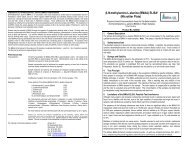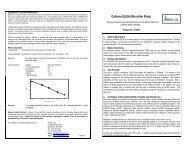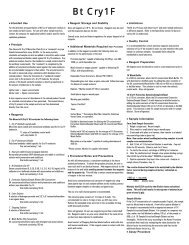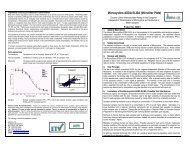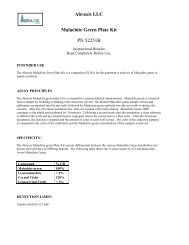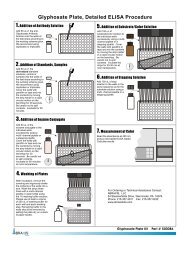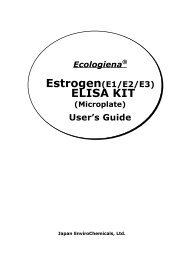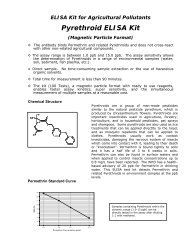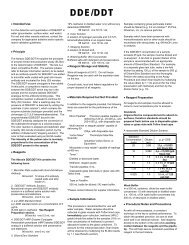Saxitoxin (PSP) ELISA, Microtiter Plate - Abraxis
Saxitoxin (PSP) ELISA, Microtiter Plate - Abraxis
Saxitoxin (PSP) ELISA, Microtiter Plate - Abraxis
- No tags were found...
You also want an ePaper? Increase the reach of your titles
YUMPU automatically turns print PDFs into web optimized ePapers that Google loves.
Importance of the <strong>Saxitoxin</strong> Determination<strong>Saxitoxin</strong> is one of the “paralytic shellfish poisons” (<strong>PSP</strong>), produced by several marine dinoflagellates andfresh water algae. Contamination of shellfish with saxitoxin has been associated with harmful algal bloomsthroughout the world.In man, <strong>PSP</strong> causes dose-dependent perioral numbness or tingling sensations and progressive muscularparalysis, which can result in death through respiratory arrest. The maximum tolerance levels establishedby the EU and FDA are 40-80 ug per 100 g edible portion of fresh, frozen, or tinned shellfish.The <strong>Saxitoxin</strong> <strong>ELISA</strong> allows the determination of 42 samples in duplicate determination. Only a few millilitersof sample are required. The test can be performed in about 1 hour.Performance DataTest sensitivity:The detection limit for <strong>Saxitoxin</strong> is 0.015 ng/mL (mean of 6 blank determinationsminus 3 SD). The middle of the test (50% B/B0) is at approximately 0.09 ng/mL.Determinations close to the middle of the tests gives the most accurate results.1.0<strong>Saxitoxin</strong> (<strong>PSP</strong>) <strong>ELISA</strong>, <strong>Microtiter</strong> <strong>Plate</strong>Enzyme-Linked Immunosorbent Assay for the Determinationof <strong>Saxitoxin</strong> (<strong>PSP</strong>) in Water and Contaminated Samples1. General DescriptionProduct No. 52255BThe <strong>Saxitoxin</strong> <strong>ELISA</strong> is an immunoassay for the quantitative and sensitive detection of <strong>Saxitoxin</strong>. <strong>Saxitoxin</strong>is one of the toxins associated with paralytic shellfish poisoning (<strong>PSP</strong>). This test is suitable for thequantitative and/or qualitative detection of <strong>Saxitoxin</strong> in water samples as well as other contaminatedsamples. For shellfish samples a sample preparation is required. If necessary, positive samples can beconfirmed by HPLC, GC/MS, or other conventional methods.0.82. Safety InstructionsB/Bo (%)0.60.40.2The standard solutions in the test kit contain small amounts of <strong>Saxitoxin</strong>. In addition the substrate solutioncontains tetramethylbenzidine and the stop solution contains diluted sulfuric acid. Avoid contact of stoppingsolution with skin and mucous membranes. If these reagents come in contact with the skin, wash withwater.0.02 0.05 0.1 0.2 0.4Concentration (ng/mL)Test reproducibility: Coefficients of variation (CVs) for standards:
Working InstructionsA. Materials Provided1. <strong>Microtiter</strong> plate coated with a second antibody (sheep anti-rabbit).2. Standards (6): 0, 0.02, 0.05, 0.1, 0.2, 0.4 ng/mL3. Antibody Solution (rabbit anti-saxitoxin), 6 mL4. <strong>Saxitoxin</strong>-HRP Conjugate, 6 mL5. Sample Diluent Concentrate (10X), 2 X 25 mL. Use to dilute samples6. Wash Solution (5X) Concentrate, 100 mL7. Color Solution (TMB), 12 mL8. Stop Solution, 12 mLB. Test PreparationMicro-pipetting equipment and pipette tips for pipetting the standards and the samples are necessary. Werecommend using a multi-channel pipette or a stepping pipette for adding the antibody, the substratesolution and the stop solution in order to equalize the incubations periods of the standard solutions and thesamples on the entire microtiter plate. Please use only the reagents and standards from one package lot inone test, as they have been adjusted in combination.1. Adjust the microtiter plate and the reagents to room temperature before use.2. Remove the number of microtiter plate strips required from the foil bag. The remaining strips are storedin the foil bag and zip-locked closed. Store the remaining kit in the refrigerator (4-8°C).3. The standard solutions, enzyme conjugate, substrate and stop solution are ready to use and do notrequire any further dilutions.4. Dilute the Wash Buffer at a ratio of 1:5. If using the entire bottle (100 mL) then add to 400 mL ofdeionized or distilled water. Dilute the Sample Diluent at a ratio of 1:10 with deionized water.5. The stop solution has to be handled with care as it contains diluted H2SO4.6. Freshwater samples must be preserved immediately upon collection to prevent loss of saxitoxin fromthe samples. Please refer to the <strong>Saxitoxin</strong> in Freshwater Sample Preparation Bulletin for details.C. Assay Procedure1. Add 50 µL of the standard solutions or the samples (water) or sample extracts (shellfish) into thewells of the test strips according to the working scheme given. We recommend using duplicates ortriplicates.2. Add 50 µL of enzyme conjugate solution to the individual wells successively using a multi- channelpipette or a stepping pipette.3. Add 50 µL of antibody solution to the individual wells successively using a multi- channel pipette or astepping pipette. Cover the wells with parafilm or tape and mix the contents by moving the strip holderin a rapid circular motion on the benchtop for about 30 seconds. Be careful not to spill contents.4. Incubate the strips for 30 min at room temperature.5. Wash the strips four times using the washing buffer solution. Please use at least a volume of 300 µL ofwashing buffer for each well and each washing step. Remaining buffer in the wells should be removedby patting the plate dry on a stack of paper towels.6. Add 100 µL of substrate solution to the wells. The strips are incubated for 30 min at roomtemperature. Protect the strips from direct sunlight.7. Add 100 µL of stop solution to the wells in the same sequence as for the substrate solution.8. Read the absorbance at 450 nm using a microplate <strong>ELISA</strong> photometer within 15 minutes after theaddition of the stopping solution.D. EvaluationThe evaluation of the <strong>ELISA</strong> can be performed using commercial <strong>ELISA</strong> evaluation programs (4-Parameter(preferred) or Logit/Log). For a manual evaluation calculate the mean absorbance value for each of thestandards. Calculate the %B/B0 for each standard by dividing the mean absorbance value for each standardby the Zero Standard (Standard 0) mean absorbance. Construct a standard curve by plotting the %B/B0 foreach standard on a vertical linear (y) axis versus the corresponding <strong>Saxitoxin</strong> concentration on horizontallogarithmic (x) axis on graph paper. %B/B0 for samples will then yield levels in ppb of <strong>Saxitoxin</strong> byinterpolation using the standard curve.The concentrations of the samples are determined using this standard curve. Samples showing lower concentration of<strong>Saxitoxin</strong> compared to standard 1 (0.02 ng/mL) are considered as negative. Samples showing a higher concentrationthan standard 6 (0.4 ng/mL) must be diluted further to obtain more accurate results.E. Additional Materials (not delivered with the test kit)1. Micro-pipettes with disposable plastic tips (10-200, and 200-1000 µL)2. Multi-channel pipette (10-300 µL) or stepper pipette with plastic tips (10-300 µL)3. <strong>Microtiter</strong> plate washer4. <strong>Microtiter</strong> plate reader (wave length 450 nm)5. Shaker for microtiter plates (optional)F. Working SchemeThe microtiter plate consists of 12 strips of 8 wells, which can be used individually for the test. The standards have to berun with each test. Never use the values of standards which have been determined in a test performed previously.Std 0-Std 5: Standards0; 0.02; 0.05; 0.10; 0.20; 0.40 ppbSam1, Sam2, etc.: SamplesG. Preparation of Sample (Mussels)NOTE: If for regulatory purposes a 100 g sample is needed, extraction solution volume should beadjusted accordingly.1. Mussels are removed from their shells, washed with deionized water and homogenized.2. Mix 10 gm of homogenized mussels with 10 mL of 0.1M HCl and boil for 5 minutes whilestirring.3. Allow to cool and centrifuge for 10 minutes at approximately 3500 g.4. Adjust pH to < pH 4.0 with 5 N HCl.5. Remove 10 uL and dilute to 10 mL with Sample Dilution Buffer (1:1,000 dilution).6. Run in the assay as sample (Assay Procedure step 1).The STX concentration in the samples is determined by multiplying the concentration of the diluted extractby a factor of 2,000. Highly contaminated samples (outside the range of the curve), should be dilutedfurther and re-analyzed, we recommend further dilutions of 1:10 with sample dilution buffer. The dilutionfactor will then be 20,000. Samples with low contamination of STX or samples that contain STX congenerswith low cross-reactivity (see chart) can be detected in the assay by diluting samples 1:250 beforeanalysis. The assay has low cross-reactivity against GTX 1 & 4, therefore food samples containing thesecongeners at low concentrations might be underestimated by this <strong>ELISA</strong>.H. Alternative Sample Preparation1. Mussels are removed from their shells, washed with deionized water, dried and homogenized using aPolytron or equivalent.2. A 1.0 gm portion is then mixed with 6 mL methanol/DI water (80/20) using a Polytron or equivalent.3. Centrifuge mixture for 10 minutes at 3000 g. Collect supernatant.4. Add 2 mL methanol/deionized water (80/20) to the mussel tissue residue. Re-centrifuge the mixture for10 minutes. Add supernatant to first portion.5. Bring the volume of the collected supernatant to 10 mL with methanol deionized water (80/20). Filterextract through a 0.45 um filter (Millex HV, Millipore).6. Remove 10 uL and dilute to 1.0 mL with sample Dilution Buffer (1:100 dilution), then analyze as samples(Assay Procedure, step 1). The STX concentration in the samples is determined by multiplying theconcentration of the diluted extract by a factor of 1,000.




